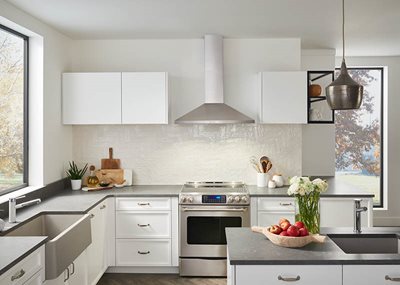Range Hood vs Over-the-Range Microwave: Why Proper Ventilation Matters
A lot of thought goes into choosing the right kitchen appliances. Color, finish, size, and placement all shape how a kitchen functions. Big families often need large refrigerators. New parents may prioritize a dishwasher with bottle washing cycles. Home cooks who love experimenting will want a multifunction gas range. Busy households rely on a microwave for quick meals.

Then comes the tricky question: where should the microwave go?
It is usually too large for the countertop and too small to justify its own dedicated cabinet. As microwaves evolved, more placement options have become available including microwave drawers, island storage, wall niches, and dedicated shelves.
But there is one location that continues to cause problems for indoor air quality: above the range.
Learn more about why ventilation is essential here, “Range Hoods and IAQ: Why Ventilation Is Essential for a Healthier Kitchen”
Why Over the Range Microwaves Fall Short
Over the range microwaves save space but they do not provide the level of ventilation needed to maintain healthy indoor air. Even though they include a fan they are designed as microwaves first and ventilation appliances second.
Most OTR units have limited coverage. They typically extend only sixteen inches from the wall which leaves the front burners completely exposed. Steam smoke grease and combustion byproducts from the front of the cooktop escape directly into the kitchen. Without full coverage these pollutants are recirculated into the air instead of being exhausted outdoors.
In short, an OTR microwave cannot match the capture efficiency of a properly designed range hood.
Most OTR units have limited coverage. They typically extend only sixteen inches from the wall which leaves the front burners completely exposed. Steam smoke grease and combustion byproducts from the front of the cooktop escape directly into the kitchen. Without full coverage these pollutants are recirculated into the air instead of being exhausted outdoors.
In short, an OTR microwave cannot match the capture efficiency of a properly designed range hood.
What Is the Better Alternative? A Proper Range Hood
A well sized range hood offers superior capture and airflow performance. Even when installed twenty inches from the wall it can effectively remove cooking pollutants when paired with the right blower.
A common guideline is to choose a hood that moves ten CFM for every one thousand BTUs your range produces. A range with ten thousand BTUs should be paired with a hood that moves around one hundred CFM. Larger professional style ranges may require six hundred CFM or more.
Learn more about range hood CFM here, “Range Hood CFM Guide: How to Choose the Right Power for Your Kitchen”
A common guideline is to choose a hood that moves ten CFM for every one thousand BTUs your range produces. A range with ten thousand BTUs should be paired with a hood that moves around one hundred CFM. Larger professional style ranges may require six hundred CFM or more.
Learn more about range hood CFM here, “Range Hood CFM Guide: How to Choose the Right Power for Your Kitchen”
Make Up Air: An Important Consideration
As airflow increases, homeowners may need to account for make up air. Make up air replenishes the air being removed by the hood which prevents depressurization and helps maintain a balanced indoor environment. Local codes often require a make up air system when a hood moves more than four hundred one CFM.
Proper ventilation is not only about removing pollutants but also about keeping the home safe, balanced, and compliant with regulations.
Proper ventilation is not only about removing pollutants but also about keeping the home safe, balanced, and compliant with regulations.
A Range Hood Can Elevate Your Kitchen Design
Beyond performance, range hoods offer significant design opportunities. They can act as a striking focal point or they can disappear seamlessly into cabinetry. Designers can wrap power pack inserts in shiplap chrome or custom wood detailing. Hoods are available in many colors, shapes, widths, and power levels and may include features like LED lighting heat sensors or capacitive touch controls.
Where an OTR microwave limits both airflow and design possibilities, a dedicated range hood opens up creative freedom while improving the home’s air quality.
Where an OTR microwave limits both airflow and design possibilities, a dedicated range hood opens up creative freedom while improving the home’s air quality.
The Best Choice for a Healthy Beautiful Kitchen
When planning an appliance package or designing a new kitchen, consider relocating the microwave and installing a well built range hood. It delivers better capture efficiency supports healthier indoor air and gives you far more design flexibility.
Learn how to replace your OTR with a range hood.

 English
English
 English
English